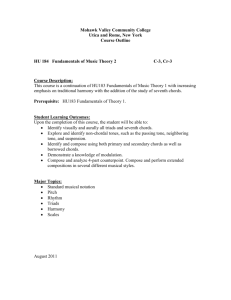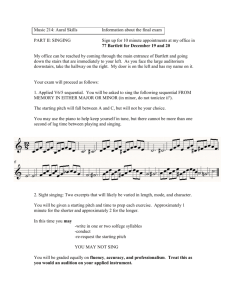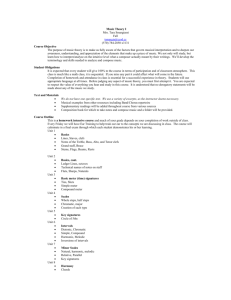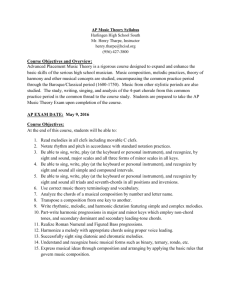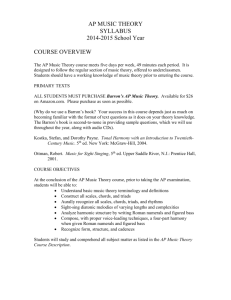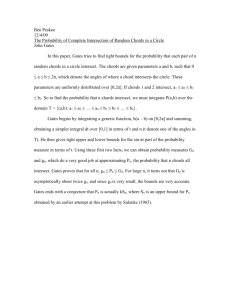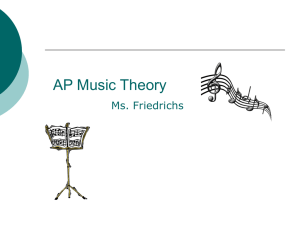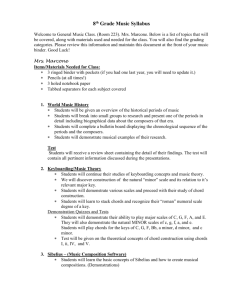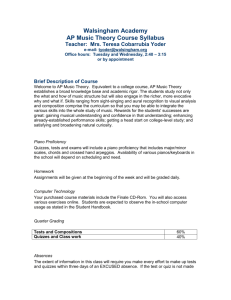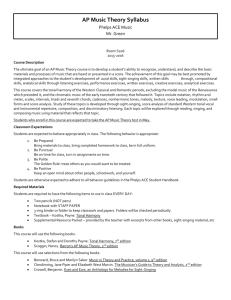AP Music Theory Course Syllabus
advertisement
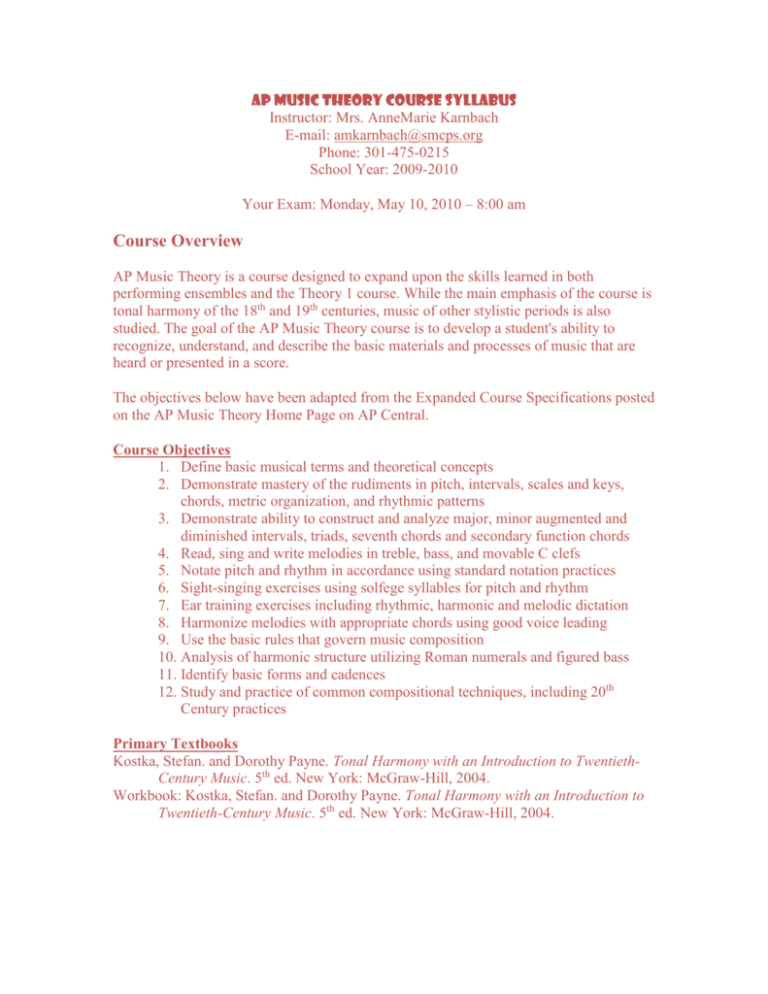
AP Music Theory Course Syllabus Instructor: Mrs. AnneMarie Karnbach E-mail: amkarnbach@smcps.org Phone: 301-475-0215 School Year: 2009-2010 Your Exam: Monday, May 10, 2010 – 8:00 am Course Overview AP Music Theory is a course designed to expand upon the skills learned in both performing ensembles and the Theory 1 course. While the main emphasis of the course is tonal harmony of the 18th and 19th centuries, music of other stylistic periods is also studied. The goal of the AP Music Theory course is to develop a student's ability to recognize, understand, and describe the basic materials and processes of music that are heard or presented in a score. The objectives below have been adapted from the Expanded Course Specifications posted on the AP Music Theory Home Page on AP Central. Course Objectives 1. Define basic musical terms and theoretical concepts 2. Demonstrate mastery of the rudiments in pitch, intervals, scales and keys, chords, metric organization, and rhythmic patterns 3. Demonstrate ability to construct and analyze major, minor augmented and diminished intervals, triads, seventh chords and secondary function chords 4. Read, sing and write melodies in treble, bass, and movable C clefs 5. Notate pitch and rhythm in accordance using standard notation practices 6. Sight-singing exercises using solfege syllables for pitch and rhythm 7. Ear training exercises including rhythmic, harmonic and melodic dictation 8. Harmonize melodies with appropriate chords using good voice leading 9. Use the basic rules that govern music composition 10. Analysis of harmonic structure utilizing Roman numerals and figured bass 11. Identify basic forms and cadences 12. Study and practice of common compositional techniques, including 20th Century practices Primary Textbooks Kostka, Stefan. and Dorothy Payne. Tonal Harmony with an Introduction to TwentiethCentury Music. 5th ed. New York: McGraw-Hill, 2004. Workbook: Kostka, Stefan. and Dorothy Payne. Tonal Harmony with an Introduction to Twentieth-Century Music. 5th ed. New York: McGraw-Hill, 2004. Course Planner This schedule is only approximate, as classes may move faster or slower from one year to the next. Written homework and reading assignments are given at each class meeting. Students are also responsible for at home practice with ear training using one of the websites listed in Other Teacher Resources. First Nine Weeks Week 1 Chapter 1: Elements of Pitch – notation; key signatures; major, minor and modal scales; scale degree names; perfect, major, minor, augmented and diminished intervals; inversion of intervals; consonance and dissonance. Week 2 Chapter 2: Elements of Rhythm – durational symbols, beat and tempo, meter, division of beat, simple and compound time signatures. Week 3 Chapter 3: Introduction to Triads and Seventh Chords – Triads, seventh chords, inversions of chords, inversion symbols and figured bass, lead sheet symbols, recognizing chords in various textures. Week 4 Chapter 4: Diatonic Chords in Major and Minor Keys – Diatonic triads in major and minor, diatonic seventh chords in major and minor. Week 5 Chapter 11: Non-Chord Tones 1 – Classification of non-chord tones, passing tones, neighboring tones, suspensions and retardations, figured bass and lead sheet symbols, embellishing a simple texture. Week 6 Chapter 12: Non-Chord Tones 2 – Appoggiaturas, escape tones, neighbor group, anticipations, pedal point, and analysis of non-chord tones. Week 7 Chapter 5: Principles of Voice Leading – Melodic line, notating chords, voicing single triad, parallel motion. Weeks 8-9 Chapter 6: Root Position Part Writing – Three and four part textures, instrumental ranges and transpositions. Second Nine Weeks Weeks 1-2 Chapter 7: Harmonic Progression – Sequences and the circle of fifths, common harmonic progressions of triads and seventh chords in the major and minor keys, harmonizing simple melodies Weeks 3-4 Chapter 8: Triads in First Inversion – Bass arpeggiation, substituted first inversion triads, parallel sixth chords, part-writing in three and four part textures, soprano – bass counterpoint Weeks 5-6 Chapter 9: Triads in Second Inversion – Bass arpeggiation and melodic bass, cadential six-four, pedal six-four, passing six-four, part writing second inversion triads. Weeks 7-9 Chapter 10: Cadences, Phrases and Periods – Musical form, cadences, cadences and harmonic rhythm, motives and phrases Third Nine Weeks Weeks 1-2 Chapter 13: The V7 Chord – Voice leading, V7 in root position, V7 in three parts, resolutions, inversions of the V7 chord, approach to the seventh Week 3 Chapter 14: The II7 and VII7 Chords – The II7, VII7 in Major and minor Week 4 Chapter 15: Other Diatonic Seventh Chords – the IV7, the VI7, the I7, the III7, seventh chords and the circle of fifths progression Weeks 5-6 Chapter 16: Secondary Functions 1 – Chromaticism and altered chords, secondary functions, secondary dominants, spelling and recognizing secondary dominants, secondary dominants in context. Weeks 7-8 Chapter 17: Secondary Functions 2 – Secondary leading-tone chords, spelling and recognizing secondary leading-tones, secondary leading-tones in context, other secondary functions Week 9 Chapter 18: Modulations Using Diatonic Common Chords – Modulations and change of key, modulation and tonicization, key relationships, common-chord modulations, analyzing common-chord modulations Fourth Nine Weeks Week 1 Chapter 18 continued Week 2 Chapter 20: Binary and Ternary Forms – Formal terminology, binary forms, ternary forms, rounded binary forms, 12-Bar blues, other formal designs Week 3 Chapter 28: An Introduction to Twentieth-Century Practices – Impressionism, Scales, Chordal Structure, Parallelism, Pandiatonicism, Rhythm and Meter, Set Theory, TwelveTone Technique, Tonal Serialization, Aleatory or Chance Music, Texture and Expanded Instrumental Resources, Electronic Music Weeks 4-6 Practice AP Exams Weeks 7-9 Final Projects and Performances Teaching Strategies/Student Activities When teaching concepts, every effort is make to provide aural stimulus for each example, sometimes from a CD, sometimes from a live playing. This helps students with recognition and audiation. When possible, students will also be able to utilize the piano lab for practice. Approximately 45 minutes of sight-singing is incorporated on a weekly basis. At the start of the year students are placed at an appropriate sight-singing level, from novice to more experienced. The students then work on increasing their sight-singing skills from where they are in preparation for the exam. The first nine weeks students will prepare sightsinging over the week. Over the rest of the year, students are given progressively less time to prepare the sight-singing in class. There are weekly quizzes checking progress and it is tested formally at the midterm and at the end of each quarter. Students practice single-line, two-part and four-part dictation on their own and in class. There are quizzes monthly to check for understanding, and dictation is tested formally at the midterm and at the end of each quarter. Students are required to complete a full analysis of a Bach Chorale or other short work each month. The analysis includes all chords, non-chord tones, and secondary functions as appropriate to where the class is. These are due the first Monday of every month, and are discussed in class. Listening activities are also included on a weekly basis. Students have “Listening Notebooks” in which they record thoughts and concepts heard each time. The examples are appropriate to unit being studied. All students complete a “Chance Music” project. In this project students create an idea to write a composition using a chance idea. They then bring in any necessary materials and complete the project. Students then work with Finale and enter the composition into the computer where they generate a final copy of their composition. Students are also required to complete a final project at the end of the year. Students may select from a research paper that is presented to the class or an original composition utilizing concepts from the year performed for the class. When possible, live performances are encouraged. Grading Policy Grading is broken down according to the following: o Participation and Attendance 20% (HAC-CW) Daily participation, on time, prepared o Formative Assessments 40% (HAC-T) Class Assignments Projects o Summative Assessments 40% (HAC-P) Major Exams Classroom Materials Students will be provided with a comprehensive Music Theory Vocabulary packet that should be completed over the course of the year. Pencils will be expected for all assignments. There is a $52.00 fee for the workbook. Classroom Rules Students will follow St. Mary’s County Public Schools Dress Code. There is No Food or Drink permitted in the classrooms. Students are to be in seat when final bell rings. Students are to have all books at all times. Homework is graded at the beginning of class unless otherwise arranged (excused absences). Late work is accepted one day past due, for partial credit. Arrangements may be made to resubmit work for improving grades, at my discretion. Students are expected to actively participate in classroom discussion and demonstrations each week. You are expected to complete any assigned homework and to maintain a comprehensive theory notebook that includes all handouts, quizzes and analyses. There are quizzes at the end of each unit, a mid-term exam given, and corrections to mistakes are due the following class day. Other Teacher Resources College Board AP Music Theory Course Description. 2006. The Hymnal for Worship & Celebration. Nashville, TN: Word Music, 1986. Bach, J.S. 371 Four-Part Chorals, Vol 1. New York: Kalmus, 1985. Aldwell, Edward, and Carl Schachter. Harmony & Voice Leading. 3rd ed. Belmont, CA: Thomas Learning, 2003. Benjamin, Thomas, Michael Horvit, and Robert Nelson. Music for Analysis. 5th ed. Belmont, CA: Thomas Learning, 2001. Benjamin, Thomas, Michael Horvit, and Robert Nelson. Music for Sight Singing. 3rd ed. Belmont, CA: Thomas Learning, 2000. Benward, Bruce, and J. Timothy Kolosick. Ear Training: A Technique for Listening. 5th ed. Boston: McGraw-Hill, 1996. Benward, Bruce, and Maureen A. Carr. Sightsinging Complete. 6th ed. Boston: McGrawHill, 1999. Benward, Bruce, and Gary White. Music in Theory and Practice, Vol 1, 7th ed. New York: McGraw-Hill, 2003. Benward, Bruce, and Gary White. Music in Theory and Practice, Vol 2, 7th ed. New York: McGraw-Hill, 2003. Berkowitz, Sol, Gabriel Fontrier, and Leo Kraft. A New Approach to Sight Singing. 3rd ed. New York: W. W. Norton & Company, 1986. Crowe, Edgar, Annie Lawton, and W. Gillies Whittaker. The Folk Song Sight-Singing Series, Books 1-4. Oxford University Press. Fuller, Sarah. European Musical Heritage: 800-1750. 1st ed. New York: McGraw-Hill, 1987. Gauldin, Robert. Harmonic Practice in Tonal Music. 1st ed. New York: W. W. Norton & Company, 1997. Kostka, Stefan, and Roger Graybill. Anthology of Music for Analysis. New Jersey: Prentice Hall, 2004. Lerner-Sexton, Marie. AP Teacher’s Guide: AP Music Theory. Ottoman, Robert. Music for Sight Singing. 3rd ed. Englewood Cliffs, N.J.: Simon and Schuster, 1986. Surmani, Karen Farnum, Morton Manus, and Andrew Surmani. Essentials of Music Theory (Software) v. 2.0. Turek, Ralph. The Elements of Music: Concepts and Applications, Vol. 1. 2nd ed. New York: McGraw-Hill, 1996. Turek, Ralph. The Elements of Music: Concepts and Applications, Vol. 2. 2nd ed. New York: McGraw-Hill, 1996. Wedge, George A. Applied Harmony: Diatonic. New York: G. Schirmer, 1930. Wedge, George A. Applied Harmony: Chromatic. New York: G. Schirmer, 1931. White, Gary. Instrumental Arranging. Wm. Brown Publishing, 1992. Important Websites http://apcentral.collegeboard.com - AP Central http://www.good-ear.com/ – assists with ear training, interval identification http://www.musictheory.net/ – assists in fundamental theory skills http://www.studystack.com/flashcard-497 - music vocabulary flashcards http://people.virginia.edu/~pdr4h/musicpaper/ - blank staff paper http://www.gmajormusictheory.org/index.html - fundamental music theory worksheets http://www.teoria.com/ - tutorials in theory, also available in Spanish http://www.dlib.indiana.edu/variations/scores/ - online musical scores http://www.music.vt.edu/musicdictionary/ - music dictionary http://library.thinkquest.org/10400/html/ - Online Music Encyclopedia http://www.freestaffpaper.cjb.net/ - Free staff paper, not accessible at school http://www.finalemusic.com/ - Music software http://midiworld.com/midifile.htm - MIDI files http://www.edly.com/ - Educational musical adventures http://mto.societymusictheory.org/ - Music Theory online journal http://www.mibac.com/Pages/Theory/Main_Theory.htm - Music Software http://members.aol.com/chordmaps/ - Music Theory for Songwriters, not accessible at school http://library.thinkquest.org/15413/theory/theory.htm - Music Theory review http://library.thinkquest.org/15413/theory/theory.htm - Transposition chart http://music-theory.com/ - Music Theory review
